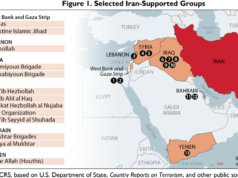“Thanks to the support of Hamas, al-Qaeda is entering Gaza,” Palestinian Authority (PA) President Mahmoud Abbas told an Italian television station in July, just after the violent Hamas takeover of Gaza. “It is Hamas that is protecting al-Qaeda, and through its bloody behavior, Hamas has become very close to al-Qaeda. That is why Gaza is in danger and needs help.”
Gaza is undeniably a perfect breeding ground for al-Qaeda. Usama bin Laden’s terror network has historically exploited areas of weak central authority and weak states commonly characterized by deteriorating living standards, corruption, and a marked lack of civil society and social services.
With Hamas now firmly in control of the Gaza Strip, but with little evidence of joint attacks by Hamas and al-Qaeda on record, what are the prospects of a partnership?
Shared Ideology
In 2004, according to analysts Yaakov Amidror and David Keyes, Israeli intelligence discovered that Hamas was distributing computer CDs throughout the West Bank and Gaza lauding jihadists in Afghanistan, Kashmir, and Chechnya. The disk reportedly featured a montage of the faces of Sheikh Ahmed Yassin (the late leader of Hamas), Usama bin Laden, and Chechen jihadist Shamil Basayev. In this way, Hamas projected its identification with al-Qaeda and the broader jihadist movement.
Al-Qaeda, for its part, has also demonstrated support for the Hamas cause by attacking Israeli and Jewish targets. In recent years, the global terror network has attacked an Israeli hotel in Kenya (2002), synagogues in Tunisia (2002) and Turkey (2003), and a Jewish center in Morocco (2003).
The jihadist ideologies of the two groups, founded within a year of one another, are inextricably linked. Hamas, founded in 1988 during the eruption of the first intifada, is a breakaway faction of the Palestinian Muslim Brotherhood. Usama bin Laden and prominent Palestinian Muslim Brotherhood figure Abdullah Azzam founded al-Qaeda the following year, as the Soviet army withdrew from Afghanistan. Subsequent al-Qaeda figureheads, including Ayman al-Zawahiri, bin Laden’s second in command, and Khaled Sheikh Mohammed, the mastermind behind the September 11, 2001, terrorist attacks, were Muslim Brothers.
Unquestionably, al-Qaeda and Hamas both embrace the xenophobic and chauvinistic Muslim Brotherhood-based worldview. Both organizations believe this interpretation of Islam should dominate the globe, and that violence to achieve that end is justifiable. Finally, both groups believe that compromise, particularly with the West, is not an option.
The Recent Rift
The ideologies of the two groups are so intertwined that al-Qaeda publicly chastised Hamas for betraying its Islamic principles by entering a secular, democratic political contest with Fatah in the 2006 Palestinian Authority elections. Zawahiri blasted Hamas, saying it “joined the surrender train,” and that it was on “a picnic with the U.S. Satan and his Saudi agent.” Similarly, Abu Musab al-Zarqawi (killed in June 2006 by U.S. forces) denounced Hamas for taking part in the elections, saying that Palestinians had “other choices” — perhaps a reference to joining forces with al-Qaeda.
After Hamas assaulted and overthrew Fatah’s forces in the Gaza Strip this summer, Zawahiri issued an audio message assuring, “our brothers, the Hamas mujahedin, that we and the entire Muslim nation stand along side you.” Now that Hamas rejected power-sharing in Gaza in favor of brute force, bin Laden’s deputy pledges to help facilitate the “passage of weapons and supplies from neighboring countries” into the Gaza Strip.
Known Ties
This would not be the first time the two groups worked together. In the early and mid-1990s, Hamas members received paramilitary training and even attended Islamist conferences in Sudan that bin Laden and members of his budding network reportedly attended.
When the 2000 intifada erupted in the Palestinian territories, bin Laden reportedly sent emissaries to Hamas on two separate occasions (September 2000 and January 2001). While most analysts believe Hamas rejected al-Qaeda’s overtures to assist in the anti-Israel violence, Hamas never closed the door. The Washington Post quoted U.S. government sources confirming a 2003 meeting, “between al-Qaeda, Hamas, and Hizbullah figures.”
Recent reportage suggests that communication between the two groups continues. In 2006, Hamas operative Muhammad Sayyam reportedly met members of the terrorist organization Hizbul Mujahidin, an al-Qaeda affiliate, in Kashmir. The two groups have little to nothing in common, given the geographic distance that separates them. Kashmir may have been an ideal lawless territory to discuss ideological, and perhaps logistical, cooperation.
It was also reported in the Arab media in 2006 that Hamas chief Khaled Meshal met in Yemen with Abd al-Majid al-Zindani, a man the U.S. Treasury designated in 2004 for his ties to al-Qaeda. Zindani stated that, “the support we can provide [to Hamas] at present is money.”
Shared Financing
Zindani is not the only terror financier backing both groups. Fellow Yemeni national Mohammed al-Moayad, a prominent businessman, also claims to have provided funds and materiel to both al-Qaeda and Hamas. Further, the U.S. Treasury designated Saudi businessman Yasin al-Qadi as a terrorist financier in 2001 for funding al-Qaeda and Hamas.
The U.S. Government has also identified several U.S. charities as supporting both groups. The Holy Land Foundation (HLF) and Benevolence International Foundation (BIF), both shut down by the U.S. Treasury, may have had financial ties to both Hamas and al-Qaeda. Bank al-Taqwa, another Treasury designee, has funded al-Qaeda, in addition to facilitating the transfer of some $60 million to Hamas in 1997.
The SITE Institute, a think tank on terrorism, notes an overlap of financial networks between the al-Qaeda affiliated International Islamic Relief Organization (IIRO) and Hamas. Documents uncovered by the Israelis detail “an IIRO program devised to financially compensate the families of Hamas suicide bombers.” IIRO was led by bin Laden’s late brother-in-law, Muhammad Jamal Khalifa, in the late 1980s and early 1990s. According to a former FBI analyst, IIRO also donated some $280,000 to Hamas charities.
The cases of HLF, Taqwa, BIF, and IIRO prompt questions of whether Hamas and al-Qaeda knowingly cooperate on fundraising. Future Treasury designations, in which sensitive information is declassified for the public, may provide a clearer picture.
Training and Operations
In 2000, Israel uncovered an al-Qaeda network in Gaza, led by Hamas operative Nabil Okal, who trained with al-Qaeda in Afghanistan in the late 1990s. Thus began a long string of alarming discoveries.
In 2003, Israel arrested three Hamas fighters returning from al-Qaeda training camps in Afghanistan. That same year, Jordanian security confirmed to Time magazine that two Hamas members went on a recruiting mission in Afghanistan for al-Qaeda fighters. Israel also learned that British citizens-turned-suicide bombers, Mohammed Hanif and Omar Sharif, may have been recruited by al-Qaeda to carry out Hamas attacks. These men of Pakistani origin were responsible for the April 2003 suicide carnage at Mike’s Place, a Tel Aviv bar, that killed three and wounded 50.
About a year after Hamas leader Mahmoud al-Zahar warned the Italian media that al-Qaeda was in the territories, Israel announced in March 2006 that it arrested two al-Qaeda operatives, Azzam Abu al-Ads and Bilal Hafnawy, in Nablus. The two reportedly planned to carry out suicide attacks inside Israel.
In 2006, Hamas Interior Minister Said Sayyam stated that he would not order the arrests of operatives who carried out attacks against Israel. This was tantamount to an invitation for al-Qaeda and other terrorist groups to join Hamas in its war against Israel. Embattled PA President Mahmoud Abbas has since stated that al-Qaeda maintains a presence in the West Bank and Gaza. Admittedly, Abbas may be playing the al-Qaeda card to frighten the West into supporting his Fatah faction over Hamas, but there is no denying that ties between the two terror groups exist.
The Lebanon Connection
One additional concern is that al-Qaeda has significant interaction with Palestinians in Lebanon, where an al-Qaeda affiliate group called Asbat al-Ansar operates with utter impunity in the Ein al-Hilweh refugee camp. According to the State Department, Asbat “receives money through international Sunni extremist networks and bin Laden’s al-Qaeda network.” These fighters are as committed to the global vision of al-Qaeda as they are to Israel’s destruction.
Nahr al-Bared is another refugee camp in Lebanon that exposes Palestinians to al-Qaeda. The camp made headlines in May 2007, when Fatah al-Islam, a new al-Qaeda affiliate group, clashed with Lebanese forces, leaving dozens dead. The group is led by Shaker Abssi, a Palestinian jihadist linked to the late Abu Musab al-Zarqawi. Both men were sentenced to death in absentia in Jordan for killing U.S. diplomat Laurence Foley in 2002. The U.S. designated Fatah al-Islam in August 2007 for its ties to al-Qaeda.
These Lebanese splinter groups expose the already-radicalized Palestinian refugee populations to the broader al-Qaeda network. Since neither Hamas nor al-Qaeda require membership cards, cross-fertilization between these jihadi organizations and Hamas is an obvious concern.
End Game
Hamas and al-Qaeda will always share core ideological tenets. This will inevitably yield individuals and cells sympathetic to both groups. Accordingly, al-Qaeda and Hamas may continue to share financial networks, such as those dismantled by the Treasury Department in recent years.
Similarly, there can be little doubt that Israeli and American intelligence organizations will continue to uncover operational and logistical connections between the two organizations. The most obvious overlaps will likely be observed in Lebanon. But, since Israel’s destruction is Hamas’ ultimate goal, and al-Qaeda can unquestionably help plan and mount attacks, cooperation is also possible in Gaza.
Still, a significant al-Qaeda presence in Gaza is not realistic. Hamas is a fiercely independent organization. The July 2007 coup handed the terrorist group its own territory, which the group will jealously guard. Hamas would never knowingly allow al-Qaeda to challenge its authority. For this reason, al-Qaeda will likely be contained to limited cooperation with Hamas in attacks against Israel.
Limited cooperation, however, may not mean limited risk. Israel must now be wary of the technology, training, and know-how that al-Qaeda can more easily bring to its doorstep.
Jonathan Schanzer, a former Treasury intelligence analyst, is director of policy for the Jewish Policy Center. He is author of Al-Qaeda’s Armies: Middle East Affiliate Groups and the Next Generation of Terror.





